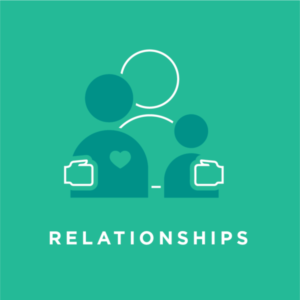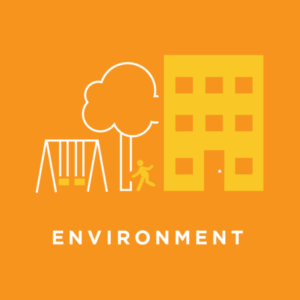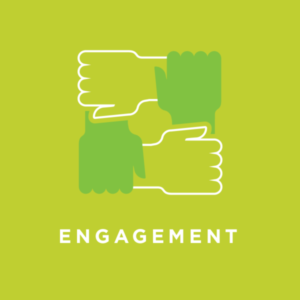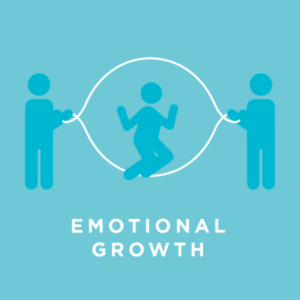Six Standards and Four Building Blocks of HOPE
What is the difference between the Six Standards of HOPE and the Four Building Blocks of HOPE?
The Four Building Blocks of HOPE are the key types of positive childhood experiences (PCEs) that children need to thrive. These PCE’s protect against Adverse Childhood Experiences (ACEs) and promote healing and well-being after ACE’s.
The HOPE Framework and the Four Building Blocks of HOPE can be used with individual families. It can also be used organizationally. When organizations want to systemically promote equitable access to these key types of PCE’s, we encourage they work through the Six Standards of HOPE to ensure the framework and key HOPE concepts are embedded throughout the agency.
 Relationships within the family and with other children and adults through interpersonal activities. Being in nurturing, supportive relationships are critical for children to develop into healthy, resilient adults. Individuals that recall having these types of relationships during childhood experience significantly lower rates of depression and poor mental health during adulthood.
Relationships within the family and with other children and adults through interpersonal activities. Being in nurturing, supportive relationships are critical for children to develop into healthy, resilient adults. Individuals that recall having these types of relationships during childhood experience significantly lower rates of depression and poor mental health during adulthood.
 Safe, stable, and equitable environments for living, playing, and learning at home and in school. Children who live, learn, and play in safe, stable, and equitable environments are less likely to experience poor mental and physical health as adults.
Safe, stable, and equitable environments for living, playing, and learning at home and in school. Children who live, learn, and play in safe, stable, and equitable environments are less likely to experience poor mental and physical health as adults.
 Social and civic engagement to develop a sense of belonging and connectedness. Children need to feel connected to their communities, loved, and appreciated. Involvement in social institutions and environments, awareness of cultural customs and traditions, and a sense that they matter and belong helps them develop into secure and resilient adults.
Social and civic engagement to develop a sense of belonging and connectedness. Children need to feel connected to their communities, loved, and appreciated. Involvement in social institutions and environments, awareness of cultural customs and traditions, and a sense that they matter and belong helps them develop into secure and resilient adults.
 Emotional growth through playing and interacting with peers for self-awareness and self-regulation. Children need to have a lot of opportunities to develop their sense of self-awareness and social cognition, learn how to self-regulate emotions and behavior, and acquire skills needed to respond functionally and productively to challenges.
Emotional growth through playing and interacting with peers for self-awareness and self-regulation. Children need to have a lot of opportunities to develop their sense of self-awareness and social cognition, learn how to self-regulate emotions and behavior, and acquire skills needed to respond functionally and productively to challenges.
The Six Standards of HOPE
Standard 1: Knowledge of the HOPE Framework
The HOPE certification process offers organizations the opportunity to ensure that all staff have received training on the HOPE framework. This includes working HOPE training into the onboarding process for new staff. This Standard can be achieved in multiple ways including HOPE trainings offered by the HOPE National Resource Center, offering staff access to HOPE online modules, partnering with HOPE to create an organizational-specific online resources, or training facilitators in-house for ongoing sustainability.
Standard 2: Supporting Family Strengths and Resilience
To support moving away from a paternalistic approach to a truly strengths-based partnership with families, organizations are encouraged to meaningfully engage those with lived experience in their planning and programming. Having families at the table reviewing policies, new forms, programs, and evaluations provides structures for family engagement.
Standard 3: Anti-Racist Practice and Culturally Resonant Care
Organizations are encouraged to look at their data to better understand disparities in access to their services, outcomes in services, and access to the Four Building Blocks of HOPE. The HOPE framework then encourages organizations to work with those individuals affected by the disparities to better understand them and to implement meaningful systems change.
Standard 4: Amplifying the Four Building Blocks of HOPE
Depending on the local context, organizations may have the potential to have “Moments of HOPE” and call out the Four Building Blocks of HOPE in action interactions with families. This includes the ways in the physical environment, and the processes which organizations conduct screenings and assessments, share referrals, develop goals with families, and create service plans.
Standard 5: Continuous Learning and Improvement
Ongoing evaluation is a key component to HOPEful practice. This continuous learning can often be integrated into existing quality improvement processes. HOPE continuous learning includes processes that include actively collecting the feedback of staff and family members on programming in ways that feel safe for those providing feedback.
Standard 6: The Bridge to HOPE
Leadership buy-in sets the stage for HOPE-informed organizations, beginning when the organization initiates the change process, and continues throughout. This will ensure that all other standards can be met – including the development or changing of policies that are necessary to achieve HOPEful practice. Leadership engagement ensures the creation of an internal culture of HOPE that prioritizes and celebrates using a strengths-based lens and promoting access to the Building Blocks of HOPE for staff and community members.
